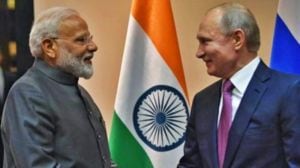Click here to join Express Pune WhatsApp channel and get a curated list of our stories
No cuts or edits, one-shot film achieves technological and artistic landmark
Lomad is now travelling the festival circuit and has won awards at the Seattle Film Festival and the Central Florida Film Festival, among others.
 A still from the movie 'Lomad'.
A still from the movie 'Lomad'. When Delhi-based Hemwant Tiwari decided to make the film, Lomad (The Fox), he planned to do it in a single shot. The camera is switched on once, rolls and there is a cut only after the film’s hour-and-a-half duration.
The first attempt was a failure, as the card finished in 88 minutes.
But Tiwari and his team, whose lead actors as well as the cameraman are FTII graduates, got it right the next time. Lomad is now travelling the festival circuit and has won awards at the Seattle Film Festival and the Central Florida Film Festival, among others.
In 2014, Hollywood film Birdman had been edited to appear as a continuous shot to be closer to reality, which has no editing.
Tiwari’s inspiration in this black-and-white venture was Alfred Hitchcock. “The only reason I wanted to make a black-and-white single-shot film is that I wanted to give the audience something different. The focus and precision we required made this a challenging process,” he says, adding that Lomad is the world’s first black-and-white single-shot film.
Lomad is a thriller that revolves around a man and a woman who meet at a certain location. They had had an affair in school and have found each other after a decade on social media. Both are married and almost strangers but, as they try to create some magical moments, things take an unexpected turn.
When Tiwari wrote the script, he was not planning to make a one-shot film. “I just wanted to write a story that has twists. As it turned out, Lomad needed no elaborate sets but it has played with time zones,” says Tiwari, who trained in acting from Barry John Acting Studio.
Tiwari laid stress not on the shoot but on the rehearsal, going through the scenes with the cast and crew for several months until “everybody knew the choreography”.
“The film involves some running and falling. In order to have slow motion in some parts, we shot the entire film at 48fps instead of 24 fps as is usual,” he says.
Cameraman Supratim Bhol, from FTII’s class of 2008, says that when Tiwari first phoned him with the concept, he thought it was a joke. “We had to pursue this project in a dedicated and disciplined way so that we could achieve it in one shot. The practice and perfection did not involve only the actors but also the technical team. Only a close-knit team, which was really willing to make the effort, was allowed with the filmmaking. When we could achieve the film and saw it sitting in the make-up van, we were overjoyed,” says Bhol.
Post-production work entailed adding the title and credits and colour correction, among others.
– Stay updated with the latest Pune news. Follow Express Pune on Twitter here and on Facebook here. You can also join our Express Pune Telegram channel here.
Click here to join Express Pune WhatsApp channel and get a curated list of our stories









